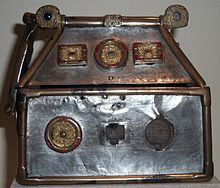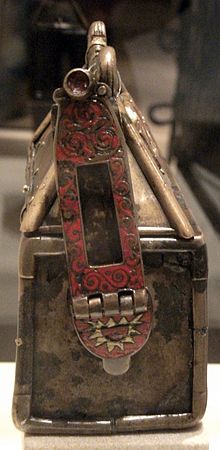- Monymusk Reliquary
-
The Monymusk Reliquary is an eighth century Scottish reliquary made of wood and metal characterised by an Insular fusion of Gaelic and Pictish design and Anglo-Saxon metalworking, probably by Ionan monks. It has been said to be the Brecbennoch of St. Columba (modern Gaelic Breac Bannoch or "embossed peaked-thing"), a sacred battle ensign of the Scottish army, used for saintly assistance, but is now thought not to be the object mentioned in historical records. Very few Insular reliquaries survive, although many are mentioned in contemporary records. It is an early example of the chasse or house-shaped reliquary, that became popular across Europe later in the Middle Ages, perhaps influenced by Insular styles. The Monymusk Reliquary is now empty. Its dimensions are W 112mm x D 51mm x H 89mm.
It is characterised by a mixture of Pictish artistic designs and Irish artistic traditions (perhaps first brought to Scotland by Irish missionaries in the sixth century), fused with Anglo-Saxon metalworking techniques, an artistic movement now classified as Insular or Hiberno-Saxon art. The casket is wooden, but is covered with silver and copper-alloy. It was made around 750, probably by Ionan monks. It shows a combination of the Pictish and Insular styles which appear in manuscripts such as the Lindisfarne Gospels (c. 715 AD). The silver plates on the front and lid of the casket are decorated with beasts leaping and twisting, and biting at their tails on a spotted field, characteristic of animal style in Celtic art. The stippled punch marks are characteristically Irish in style.
It was significant because it was said to have contained Holy relics of St. Columba, the most popular saint in mediaeval Scotland, and believed to be the "Brecbennoch of St. Columba", a sacred battle ensign of the Scottish army. It may have been handed to the abbot of Arbroath Abbey during the reign of William I (r. 1165 - 1214), who in turn passed it to someone else's care at Forglen. The custodian was charged with the care of the reliquary, so that it could be used for saintly assistance by the Scots in battle. It was carried by the Gaelic army who were victorious against the army of king Edward II of England at the Battle of Bannockburn (1314). It stayed at Forglen until the sixteenth century, when both Forglen and Monymusk came into the hands of the Forbes family. In 1712 it was transferred to Sir Francis Grant of Cullen. It stayed in the Grant collection until 1933, when it was acquired by the people. It is now in the care of the Museum of Scotland, where it is arguably one of the most important pieces in the Museum's entire collection.
References
Bibliography
- Wormald, Jenny (ed.), Scotland: A History, (Oxford, 2005), Plate 2, opp. p. 42
External links
- The Monymusk Reliquary at the National Museum of Scotland
- Friends of Grampian Stones
Categories:- Collections of the National Museums of Scotland
- Medieval Scotland
- Reliquaries
Wikimedia Foundation. 2010.


